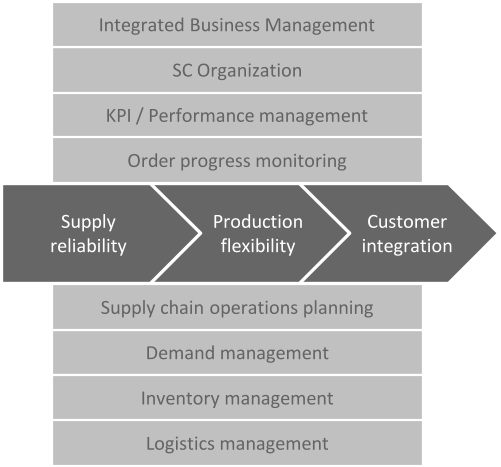

- Value Chain Excellence
- Company Business Performance
- Supply Chain Performance
- Supply Chain Strategy
- Integrated business management (S&OP)
- Digital Transformation
- Operational Improvement
- Transparency
- Complexity
- Agility
- Responsiveness
- Customer Needs
- Delivery Reliability
- SC Segmentation
- Inventory optimization
- Throughput Times
- Order Management
- Planning Excellence
- Cost management
- Logistics Cost
- Working Capital Optimization
- Supplier Optimization
- Transport Optimization
- Network Optimization
- Post Merger Integration
ADVANCED SCM - REFERENCE MODEL FOR AMBITIOUS LEADERS

High performance in an Advanced Supply Chain
Environment
•
Today’s reference model for ambitious companies is the
advanced supply chain concept. It builds on the
foundations of supply chain centric organization, but adds
targeted management concepts, and important “process
worlds” to the supply chain centric organizational design.
•
Companies which operate in an advanced supply chain
mode have already realized a consistent, internally and
externally integrated supply chain. They act as an internal
chain, and also as an external chain element towards
suppliers, and towards customers. Therefore their internal
value chain focuses on three key dimensions to enable
their operations:
o
Production flexibility to adjust to changes in product
portfolio, customer demands, and volume variations.
o
Supply reliability to ensure continuity and predictability
of materials, goods, and services required to make the
products
o
Customer integration to continually improve the ways
of interaction with the market; this builds on joint
improvement initiatives as well as on a set of targeted
practices to focus on operational excellence,
predictability, and flexibility.
•
In their operations they use a set of tactical enablers,
processes, and ways of working. They have developed
advanced ways to plan their execution, to have deep
insights into their future market demands (and the
associated risks), but also to have balanced inventories.
Their logistics are designed and equipped to have high
efficiency, but also high flexibility, reliability, and
transparency using advanced transport management
systems.
•
To manage the supply chain’s performance and
execution processes, a set of organizational enablers is
established. As a foundation, systems support
transparency in operational status, but also deliver insights
regarding the current performance levels. A stringent set
of KPI is used to monitor the performance, and a task-
force oriented approach works on continuous but also
sporadic improvements. And the overall business balance
of demand, supply, and own operational development, is
managed by an integrated business planning - Sales and
Operations Planning as top management process to
manage the entire company.
•
As a result, they have smoothly running regular operations,
and therefore can focus their energy on the occasional
extraordinary situation - deviations in volumes, short term
customer orders, and short term disturbances on the
supply side.
•
All these sophisticated tools and enablers require a solid
foundation - in data integrity, transparency, controls,
speed, reliability, and flexibility of operations. Click here to
learn more about the leading practices used by these
companies.
•
Please contact us if you want to learn more on how this
model can be applied to your organization, and improve
your operational performance.















